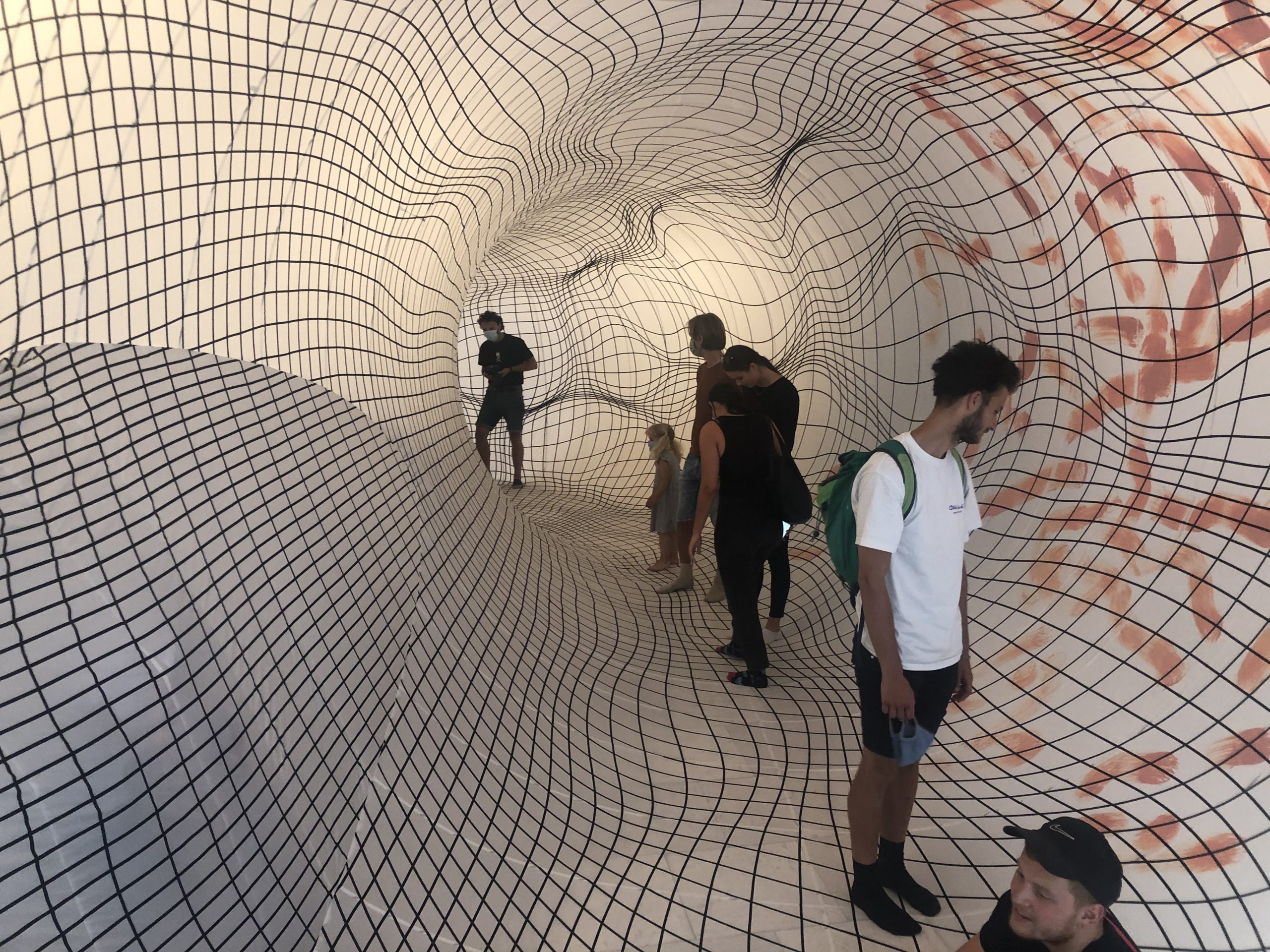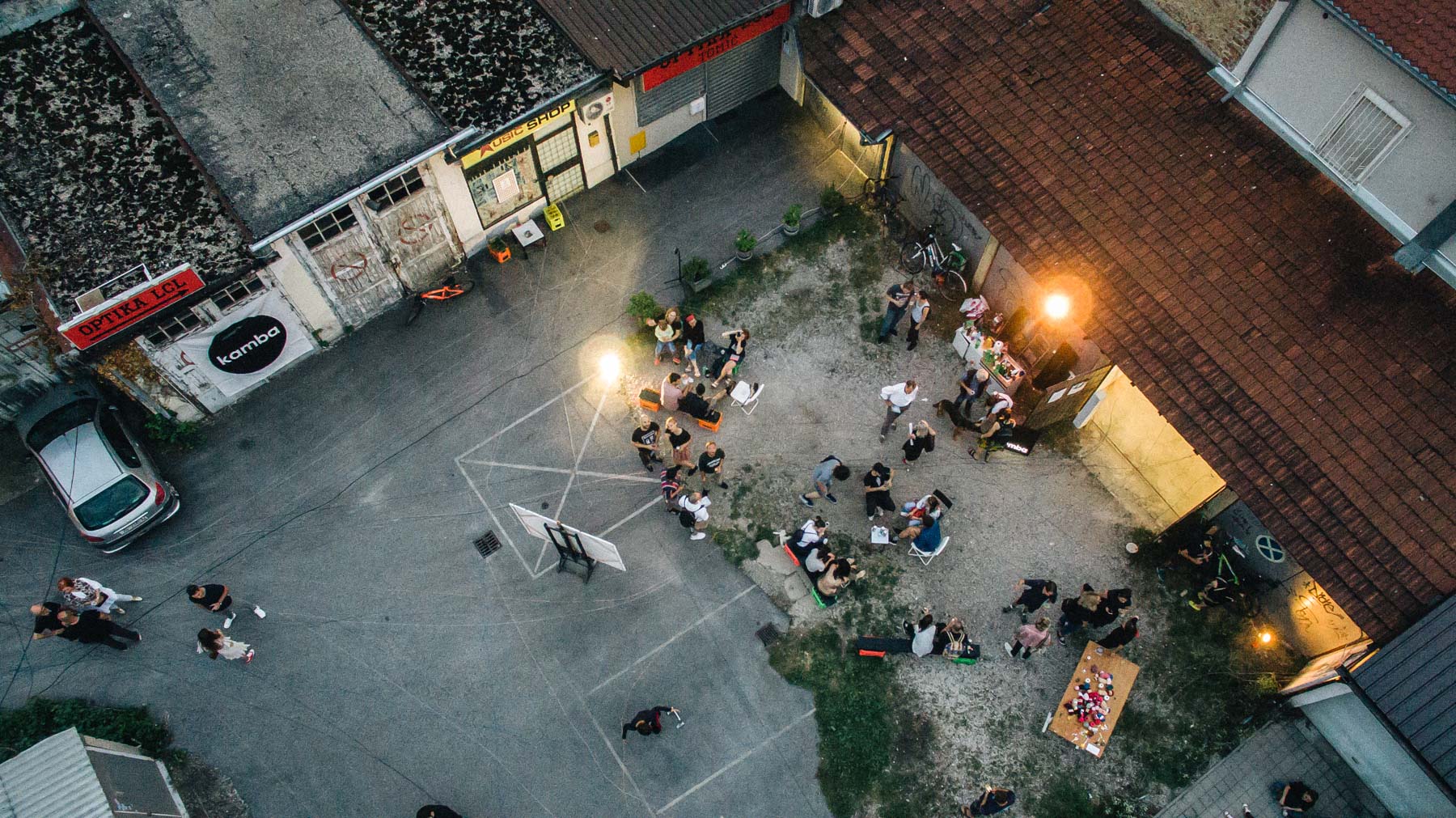In March 2023, Finnish-Italian artist Egle Oddo (b. 1975, Italy) worked for a week near the centre of Bratislava, in the vicinity of the Old Town Library, to set up a public work of art, Evolutionary Garden. The work was initiated by curator Lýdia Pribišová within her curatorial project A Plant.[1] I had the privilege to follow Oddo’s work in Bratislava and sit down with her for a little chat.[2]
Evolutionary Garden is a living sculpture that functions as a space for encounters between plants, people, and other critters. In these gardens, Oddo plants together different genera of wild and cultivated species with the idea that with time and space given to them, they could naturally evolve, change, and drift, hopefully creating new biotic assemblages and varieties. With its unusual composition, the garden merges the artificial borders between nature and culture as well as wild and urban spaces.
The garden is an ongoing process of multispecies entanglements. Here plants, worms, insects, microbes, and myriad other soil critters, as well as birds and other bigger animals take part in the becoming of the work as much as, or even more than their human collaborators. Even though the initiation of the work comes from the artist, the result is always up to these “co-protagonists”, as Oddo describes them. This way, the work allows plants and their companions to exist on their own terms, free from objectification and exploitation that usually define our relationships with nonhuman beings.
Oddo has been researching plant seeds, vegetal consciousness and agency, and plant imagery since 2007. Since then, evolutionary gardens have been established around the world, most recently in Palermo, Sicily, and a small town of Mänttä-Vilppula in Central Finland. The project is experimentative by nature and based in interdisciplinary research and collaboration with scientists from different fields.
In Bratislava the artist worked with the Gene Bank of the Slovak Republic to ensure that the seeds chosen for the garden would align with Slovakia’s surprisingly strict regulations around invasive or otherwise harmful species. The collection of seeds was chosen considering variables related to climate change, with the hope that their natural breeding might create new traits adapted to local conditions.[3] Among different medicinal plants the garden contains grains of millets to celebrate the International Year of Millets declared by the Food and Agricultural Organisation of the United Nations (FAO).[4]

Sensitivity to local conditions and communities is central to Oddo’s practice. Coming to a new place, the project starts with an orientation, during which the artist learns about the specificities of the area through collaborating with local residents, institutions and the more than human community. The orientation is based on active listening, as Oddo explains:
“With the nonhuman community, to listen means to try really to, for the moment, stop everything I’m doing and concentrate on the features that I’m presented within a natural situation. When it comes to the human community, it means to listen to their needs and the instances without judgement. This tends to create a climate of general acceptance. I think it is very important to try to offer this type of care to avoid a situation where the garden becomes a mini-occupation, or sort of parachuted reality.”
Along with the Seed Bank and the library, in Bratislava Oddo worked closely with people living in the neighbourhood who had already started to take care of the area long before the project had started. The neighbours had been planting ornamental flowers to bring beauty and joy in the quarter, to educate other people to be respectful towards them, and to encourage people to do the same. This way, the Evolutionary Garden in Bratislava entangles with the local history of urban activism.[5]
Cultivating connection
The common history of urban gardening and activism is long, taking myriad different forms from guerrilla gardening[6] to bigger communally managed agricultural sites.[7] In recent years attention towards urban gardening has increased as a solution for environmental and socio-political crises ahead, especially food insecurity caused by drought, pollution, and loss of biodiversity.[8]
The history of gardening as a revolutionary act also intertwines with that of environmental art[9], and Oddo’s work is part of this tradition. Her work entangles especially with the questions of the ownership of natural resources, capitalistic and colonialistic logic of food production, and the commodification of seeds.[10] However, despite dealing with larger political questions, Oddo does not see herself as an activist:
“I don’t stress that aspect particularly. There is definitely a political view that comes through the work naturally, and I let it shine through. I don’t disguise it or mask it. But it is not the flag of the artwork, and the artwork is not a flag.”
Rather than telling them how to act, Oddo wants to encourage people to work with plants and seeds by themselves, and this way to connect with them in a new, more empathetic way. As anthropologist Anna Lowenhaupt Tsing reminds us, human nature is always already an interspecies relationship. [11] Turning our attention to these relationships we depend on is now more important than ever. But cultivating multispecies relationships might take a little bit more effort, as Oddo states:
“Because we don’t share the same languages or the same sensorial settings completely, to develop a relationship with the nonhuman community requires more time, more attention and more concentration.”
Since plants and humans don’t speak the same language, we need to learn how to communicate in other ways. By cultivating attentiveness and curiosity, Evolutionary Gardens could function as spaces for interspecies connection and communication across differences.
Slowly…
In Bratislava, the project will continue in September 2023 with a performance activating the garden along with a discussion with experts in botany, ecology, environmentalism, and urban planning. Whether the garden is still up and thriving during this time is not up to the artist. Once Oddo is finished with setting the garden, its future is left in the hands of the local community. “The garden becomes a mirror of their choices”, the artist explains. This does not mean that she demands excessive work from the community. In fact, Oddo hopes that the plants will be mainly left on their own, with little or no interaction with humans. The garden does not need to be attended, trimmed, or weeded. Indeed, sometimes the best way to care might be to leave others be, to perform a kind of conscious neglect, as feminist scholar Maria Puig de la Bellacasa puts it.[12]
The message Oddo wants to convey is that facing the changing climate and uncertain futures we should, perhaps counter-intuitively, restrain ourselves from doing too much. In an interview with Radio Slovakia International she explains:
“Contemplation is already a very beautiful action we can do in connection to nature. We don’t need to correct nature all the time, we don’t need to improve it all the time, or to have that sort of performative attitude in bettering lands, places, or seeds.” [13]
Slowing down and doing as little as possible is an alluring thought. The common idea seems to be that the solution to the catastrophes looming ahead is to do more, do better, and do faster. We try to fix the problem the same way it was created: by controlling and optimizing the nature. But what if the better option was to go in the opposite direction? To slow down and do less? Plants already know this, for they have their own temporality that cannot be rushed. It takes a while for new ways of being to take shape.
What the garden will look like next fall, next year, or in ten years, we cannot say. All we can do is to sit down next to the garden, with millets, dandelions, and tulips, and try to sense the world from their point of view. And maybe we could learn something.

photo: Adam Šakový.
[1] A Plant is a program of Kunsthalle Bratislava in public space which aims to highlight the importance of urban greenery, especially in the context of the climate crisis. More: https://kunsthallebratislava.sk/en/program/a-plant-year-round-programme-of-kunsthalle-bratislava/
[2] As an art historian, I have been collaborating with Oddo within my doctoral research since 2021.
[3] This method is inspired by that adopted by geneticist Salvatore Ceccarelli and Stefania Grando with their Participatory Plant Breeding (PPB), mainly applied to grains. In PPB different populations are planted together and let mix, after which varieties with best characteristics are selected in collaboration with local cultivators. A wide range of crop diversity is needed for more sustainable agricultural practices and diversified food systems. Egle Oddo, “A Plant: Evolutionary Garden and Performative Habitat”, project introduction text printed on a leaflet.
[4] According to FAO, millets can grow on arid lands with minimal inputs and are resilient to changes in climate. They are therefore an ideal solution for countries to increase self-sufficiency and reduce reliance on imported cereal grains. Read more: https://www.fao.org/millets-2023/en
[5] Egle Oddo, “A Plant: Evolutionary Garden and Performative Habitat”, project introduction text printed on a leaflet.
[6] The earlies use of the term guerrilla gardening was by Liz Christy in 1973, but similar actions had been realised already earlier. Green Guerillas, “Our history”. https://www.greenguerillas.org/history
[7] The link between gardening and civic action is particularly strong in the Global South, where gardens work as fighting fields for rights to the land and means of food production between indigenous communities and global agrochemical corporations. See, for example: David Lauer, “Seeds of Resistance. From a diary of maze”, The Dark Mountain Project, 9.3.2022. https://dark-mountain.net/seeds-of-resistance/ ; La Via Campesina – International Peasants’ Movement, “The Maize Manifesto: No to GMO Maiz”, 23.1.2013. https://viacampesina.org/en/the-maize-manifesto-no-to-gmo-maiz/
[8]DJ MacCauley, ”Urban Agriculture Combats Food Insecurity, Builds Community”, Eos, 25.1.2021. https://eos.org/articles/urban-agriculture-combats-food-insecurity-builds-community ; WWF Philippines, “How Urban Gardening is Helping Us Solve the Food Crisis”, February 2020. https://wwf.org.ph/resource-center/story-archives-2020/urban-container-gardening/
[9] Take, for example, Agnes Denes’s work Wheatfield – A Confrontation, 2982, in which the artist planted and harvested a two-acre wheatfield in trash-filled Battery Park landfill in Manhattan.
[10] Egle Oddo, “Evolutionary Gardens and Performative Habitats”, RUUKKU – Studies in Artistic Research, 16 (2021) https://doi.org/10.22501/ruu.792130
[11]Anna Tsing, “Unruly Edges: Mushrooms as Companion Species”, Environmental Humanities 1 (2012): 144.
[12] Puig de la Bellacasa, María, Matters of Care – Speculative Ethics in More Than Human Worlds (Minneapolis: University of Minnesota Press, 2017), 149
[13] Egle Oddo, “Evolutionary garden in Bratislava”, interview by Marianna Palková, Radio Slovakia International, 6.4.2023 https://enrsi.rtvs.sk/articles/science-and-nature/322482/evolutionary-garden-in-bratislava



